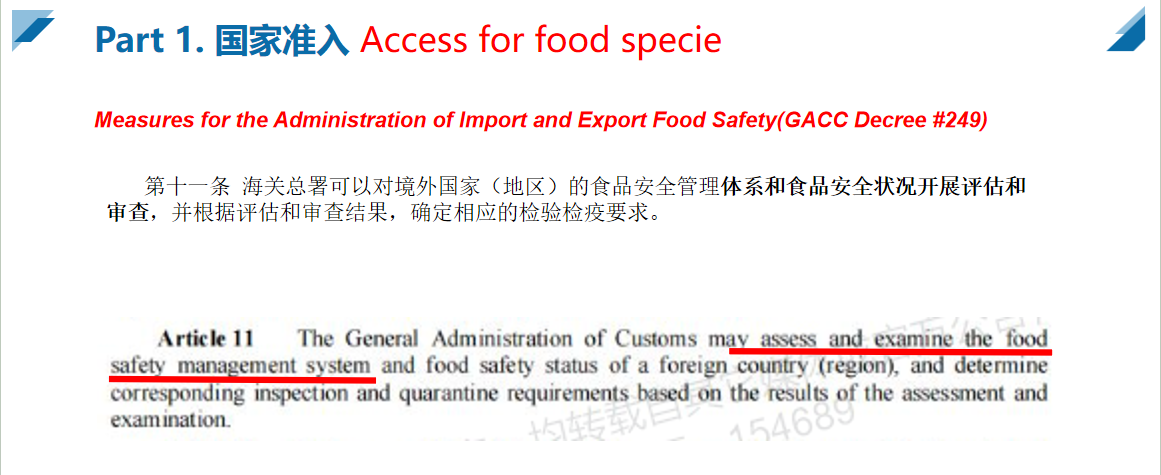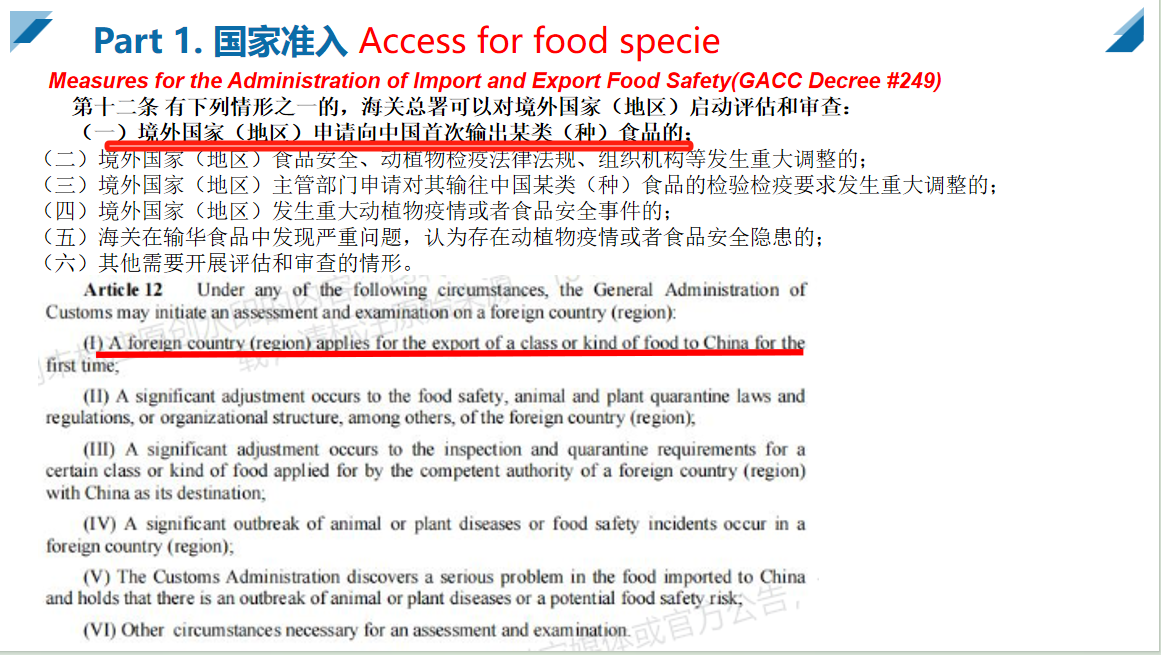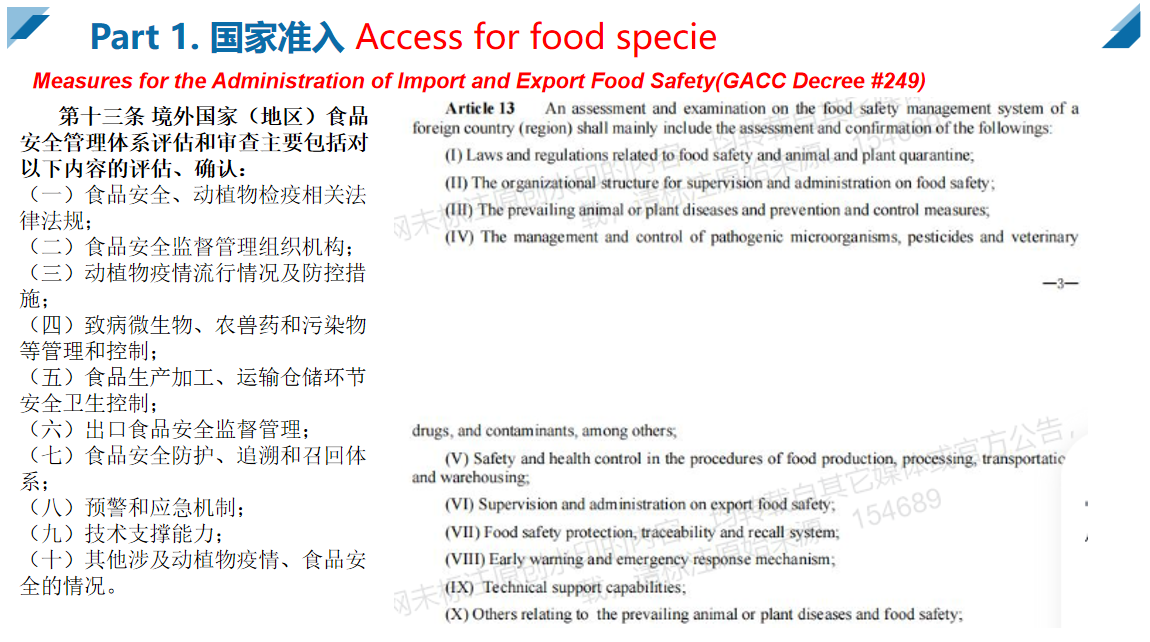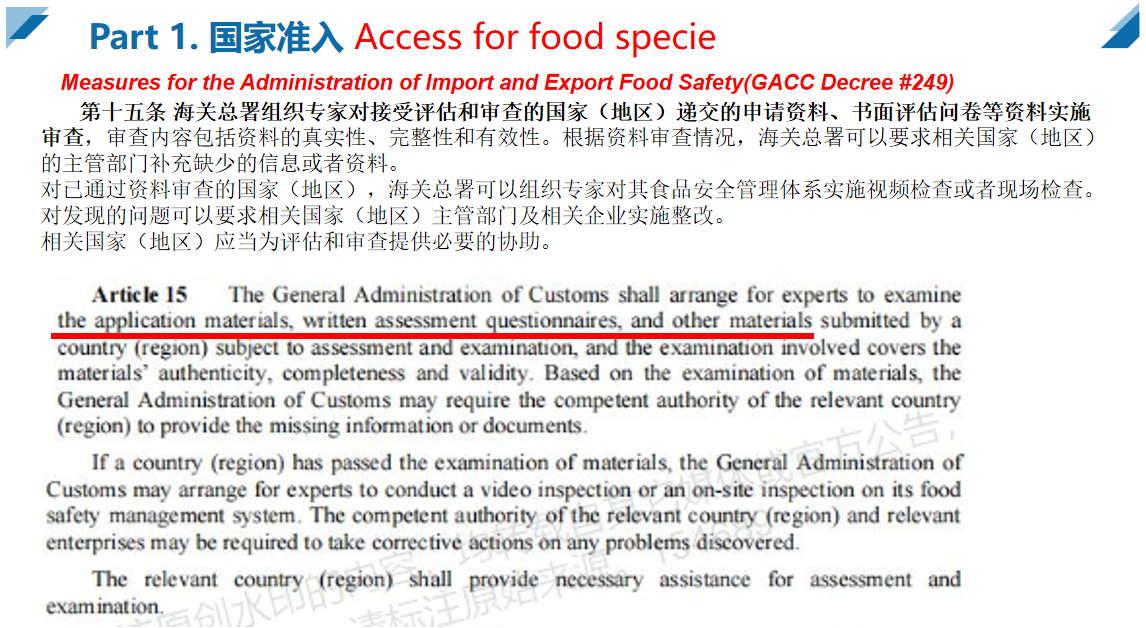行业新闻
肉类国家准入程序 National Market Access
拟输华肉类国家准入评估审查程序
Procedures of National Marcket Access of Meat to China
根据中国的法律规定和国际通行做法,在完成以下程序后,拟输出国方可对华出口肉类产品:
According to Chinese laws and international practices, the country to export meat products to China can only complete the following procedures:
(1)出口方:提出申请。
The Exporting Side: To apply for the market access.
拟输出国中央官方主管部门以书面方式向中国海关总署提出对华出口食品申请。
The country to be exported shall submit an application in writing to the General Administration of Customs of China for the export of food to China.
【优顶特提示:划重点:几个关键词:一是拟输出国“中央官方主管部门”。必须是官方主管部门,不能是企业或者其他机构;必须是中央机构(如农业部/畜牧部等),不能是某州/省的农业厅/畜牧局。二是书面方式:正式公函/外交照会。】
【Comments from OIG Research: First, the intended export country must be the "central official supervisory department". It must be an official supervisory department, not an enterprise or other institution; it must be a central institution (such as the Ministry of Agriculture/Ministry of Animal Husbandry, etc.), not the agricultural department/animal husbandry bureau of a certain state/province. Second, written form: formal official letter/diplomatic note. 】
(2)中方:决定是否启动。
Chinese Side: to decide whether to start the procedure or not
中方根据拟输出国动物疫情状况决定是否启动评估审查程序。如启动,则向拟输出国提交相关产品的风险评估问卷。China decides whether to initiate the assessment and review process based on the animal epidemic situation of the country to be exported. If initiated, a risk assessment questionnaire for the product concerned is submitted to the country to be exported.
【优顶特提示:如果存在影响该种肉类输华的动物疫情,则无法启动。但如果这种动物疫情可以通过区域化管理等方式控制风险,则可能可以启动。评估审查程序详情请查阅《拟出口国有动物疫情,能否输华? 》
【Comments from OIG Research: If there is an animal epidemic which will relevant to the meat product to be exported, this application WOULD NOT be accepted. But if the risks related to the animal epidemic can be controlled through regional management, please refer to the details of the evaluation and review process in "If an animal epidemic occurs/exists in the exporting country, could related meat products be exported to China?")
(2.a)(如果有疫情,可以区域化)双方:签署区域化协议
(If regionization of the epidemic is applicable )Both Sides: Sign a Regionization Agreement
如果出口国有动物疫情,且可以通过区域化方式确定其境内某些区域不存在疫情或疫情可控,那么经过中方专业评估,可以通过区域化方式解除符合要求区域的输华禁令。
(2.b)(如果有疫情,且无法区域化)中方:待疫情结束,或者附加特定条件(如限制动物月龄等)后,发布解禁公告
(If regionization of the epidemic is NOT applicable )Chinese Side: Issue Public Notice to Announce the End of the epdemic
如果出口国有动物疫情,且无法区域化,则必须等疫情结束后,由中方发布解禁公告(这个解禁过程也需要出口方提出申请、中方评估等程序)。
(2.c)(如果有疫情,且无法解禁)
There is an animal epidemic in the exporting country, and its meat products cannot be exported to China. However, in some cases, it is still possible to strive for access to cooked meat. The exporting country must undergo evaluation by the Chinese side and sign a protocol before exporting relevant products to China as required.
出口国存在动物疫情,其肉类产品无法输华,但有些情况下,也可争取熟制肉类准入。出口国必须经过中方评估后,双方签署议定书,方可按要求对华出口相关产品。
(3)出口方:提供资料
The Exporting Side: Provide Documents
对于中方提供问卷,拟输出国根据问卷予以回复,提供相关技术资料,具体如下图所示。
The country to be exported will reply according to the questionnaire and provide relevant technical information, including those listed below.
(4)中方:资料审查
The Chinese Side: Evaluate the Documents
中方对输出国官方提供的答卷及相关资料进行风险评估,如果评估认为出口国的食品安全卫生状况在可接受范围内,则中方将派专家组赴输出国进行实地考察。
The Chinese side will conduct a risk assessment of the answers and relevant materials provided by the official of the exporting country, and if the assessment finds that the food safety and hygiene status of the exporting country is within an acceptable range, the Chinese side will send a team of experts to the exporting country for on-site audit.
(5)中方:视频检查/实地检查
Chinese Side: Video/Virtual Audit or On-the-spot Audit
中方根据需要,开展视频检查和/或实地检查。
【优顶特提示:这种检查是体系检查,是对拟出口国的兽医卫生体系、食品安全体系的全面考察。因此,考察的内容包括文字材料涉及到的所有内容,包括:疫病疫病防控、饲料等投入品控制、农药兽药残留控制、工厂卫生控制等各个方面。考察地点通常包括:中央及地方的官方机构、实验室(疫病疫情、微生物、残留)、养殖场、加工厂、冷库等。
【Comments from OIG Research: Such an audit is a overall and comprehensive audit which covers the control system of veteriary and food safety, focuses on the prevention and control of disease & pandemic, control of inputs such as feed, control of pesticide&drug residue, processing plant's hygienic control, etc. The team will visit the sites of central&local competent authorities, labs(disease, microbiology, residue), farms, processing plants, cold store, etc.】
(6)双方:签署议定书
Both Sides: Sign the Protocol
双方就对华出口食品的检验检疫要求进行磋商,达成一致后签署议定书,并确认卫生证书内容和格式。
The two sides shall consult on the inspection and quarantine requirements of food exported to China, sign a protocol after reaching an agreement, and confirm the content and format of the health certificate.
【优顶特提示:议定书作为政府间的协议文件,一般由双方副部级及以上官员会晤时签署。因此,议定书的签署需要合适的时机。】
【Comments from OIG Research: As a government-government document, the Protocol usually is signed by officials of Vice Ministerial level or above during a meeting. So, there is some extra time needed to arrange such a ceremony of signing.】
在完成以上评估审查程序后,中方对输出国拟向中国输出食品的企业还必须按照中国的有关法律法规进行企业注册,同时拟输出国需向中国海关总署提供在华注册企业的产品种类、签字兽医官等信息,企业获得在华注册后方准对华出口。





